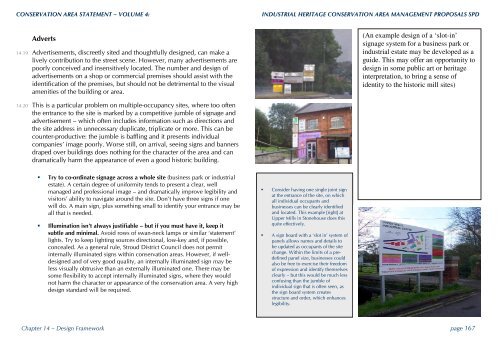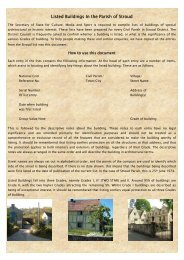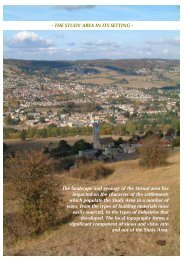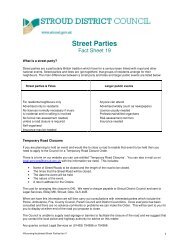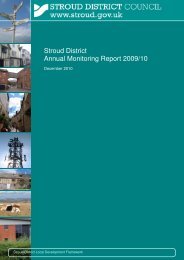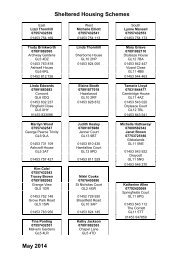DESIGN GUIDANCE: PUBLIC REALM - Stroud District Council
DESIGN GUIDANCE: PUBLIC REALM - Stroud District Council
DESIGN GUIDANCE: PUBLIC REALM - Stroud District Council
- No tags were found...
Create successful ePaper yourself
Turn your PDF publications into a flip-book with our unique Google optimized e-Paper software.
CONSERVATION AREA STATEMENT – VOLUME 4: INDUSTRIAL HERITAGE CONSERVATION AREA MANAGEMENT PROPOSALS SPDAdverts14.19 Advertisements, discreetly sited and thoughtfully designed, can make alively contribution to the street scene. However, many advertisements arepoorly conceived and insensitively located. The number and design ofadvertisements on a shop or commercial premises should assist with theidentification of the premises, but should not be detrimental to the visualamenities of the building or area.(An example design of a ‘slot-in’signage system for a business park orindustrial estate may be developed as aguide. This may offer an opportunity todesign in some public art or heritageinterpretation, to bring a sense ofidentity to the historic mill sites)14.20 This is a particular problem on multiple-occupancy sites, where too oftenthe entrance to the site is marked by a competitive jumble of signage andadvertisement – which often includes information such as directions andthe site address in unnecessary duplicate, triplicate or more. This can becounter-productive: the jumble is baffling and it presents individualcompanies’ image poorly. Worse still, on arrival, seeing signs and bannersdraped over buildings does nothing for the character of the area and candramatically harm the appearance of even a good historic building.Try to co-ordinate signage across a whole site (business park or industrialestate). A certain degree of uniformity tends to present a clear, wellmanaged and professional image – and dramatically improve legibility andvisitors’ ability to navigate around the site. Don’t have three signs if onewill do. A main sign, plus something small to identify your entrance may beall that is needed.Illumination isn’t always justifiable – but if you must have it, keep itsubtle and minimal. Avoid rows of swan-neck lamps or similar ‘statement’lights. Try to keep lighting sources directional, low-key and, if possible,concealed. As a general rule, <strong>Stroud</strong> <strong>District</strong> <strong>Council</strong> does not permitinternally illuminated signs within conservation areas. However, if welldesignedand of very good quality, an internally illuminated sign may beless visually obtrusive than an externally illuminated one. There may besome flexibility to accept internally illuminated signs, where they wouldnot harm the character or appearance of the conservation area. A very highdesign standard will be required.Consider having one single joint signat the entrance of the site, on whichall individual occupants andbusinesses can be clearly identifiedand located. This example [right] atUpper Mills in Stonehouse does thisquite effectively.A sign board with a ‘slot in’ system ofpanels allows names and details tobe updated as occupants of the sitechange. Within the limits of a predefinedpanel size, businesses couldalso be free to exercise their freedomof expression and identify themselvesclearly – but this would be much lessconfusing than the jumble ofindividual sign that is often seen, asthe sign board system createsstructure and order, which enhanceslegibility.Chapter 14 – Design Framework page 167


